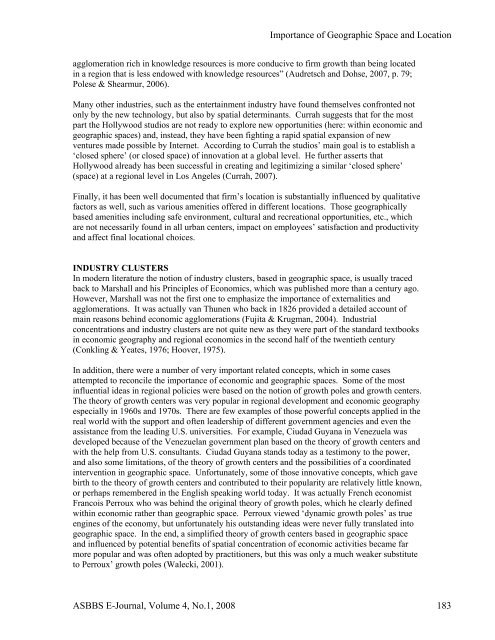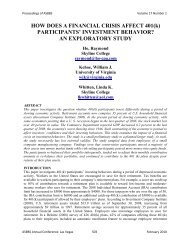stock repurchase announcements: a test of market ... - Asbbs.org
stock repurchase announcements: a test of market ... - Asbbs.org
stock repurchase announcements: a test of market ... - Asbbs.org
Create successful ePaper yourself
Turn your PDF publications into a flip-book with our unique Google optimized e-Paper software.
Importance <strong>of</strong> Geographic Space and Location<br />
agglomeration rich in knowledge resources is more conducive to firm growth than being located<br />
in a region that is less endowed with knowledge resources” (Audretsch and Dohse, 2007, p. 79;<br />
Polese & Shearmur, 2006).<br />
Many other industries, such as the entertainment industry have found themselves confronted not<br />
only by the new technology, but also by spatial determinants. Currah suggests that for the most<br />
part the Hollywood studios are not ready to explore new opportunities (here: within economic and<br />
geographic spaces) and, instead, they have been fighting a rapid spatial expansion <strong>of</strong> new<br />
ventures made possible by Internet. According to Currah the studios’ main goal is to establish a<br />
‘closed sphere’ (or closed space) <strong>of</strong> innovation at a global level. He further asserts that<br />
Hollywood already has been successful in creating and legitimizing a similar ‘closed sphere’<br />
(space) at a regional level in Los Angeles (Currah, 2007).<br />
Finally, it has been well documented that firm’s location is substantially influenced by qualitative<br />
factors as well, such as various amenities <strong>of</strong>fered in different locations. Those geographically<br />
based amenities including safe environment, cultural and recreational opportunities, etc., which<br />
are not necessarily found in all urban centers, impact on employees’ satisfaction and productivity<br />
and affect final locational choices.<br />
INDUSTRY CLUSTERS<br />
In modern literature the notion <strong>of</strong> industry clusters, based in geographic space, is usually traced<br />
back to Marshall and his Principles <strong>of</strong> Economics, which was published more than a century ago.<br />
However, Marshall was not the first one to emphasize the importance <strong>of</strong> externalities and<br />
agglomerations. It was actually van Thunen who back in 1826 provided a detailed account <strong>of</strong><br />
main reasons behind economic agglomerations (Fujita & Krugman, 2004). Industrial<br />
concentrations and industry clusters are not quite new as they were part <strong>of</strong> the standard textbooks<br />
in economic geography and regional economics in the second half <strong>of</strong> the twentieth century<br />
(Conkling & Yeates, 1976; Hoover, 1975).<br />
In addition, there were a number <strong>of</strong> very important related concepts, which in some cases<br />
attempted to reconcile the importance <strong>of</strong> economic and geographic spaces. Some <strong>of</strong> the most<br />
influential ideas in regional policies were based on the notion <strong>of</strong> growth poles and growth centers.<br />
The theory <strong>of</strong> growth centers was very popular in regional development and economic geography<br />
especially in 1960s and 1970s. There are few examples <strong>of</strong> those powerful concepts applied in the<br />
real world with the support and <strong>of</strong>ten leadership <strong>of</strong> different government agencies and even the<br />
assistance from the leading U.S. universities. For example, Ciudad Guyana in Venezuela was<br />
developed because <strong>of</strong> the Venezuelan government plan based on the theory <strong>of</strong> growth centers and<br />
with the help from U.S. consultants. Ciudad Guyana stands today as a <strong>test</strong>imony to the power,<br />
and also some limitations, <strong>of</strong> the theory <strong>of</strong> growth centers and the possibilities <strong>of</strong> a coordinated<br />
intervention in geographic space. Unfortunately, some <strong>of</strong> those innovative concepts, which gave<br />
birth to the theory <strong>of</strong> growth centers and contributed to their popularity are relatively little known,<br />
or perhaps remembered in the English speaking world today. It was actually French economist<br />
Francois Perroux who was behind the original theory <strong>of</strong> growth poles, which he clearly defined<br />
within economic rather than geographic space. Perroux viewed ‘dynamic growth poles’ as true<br />
engines <strong>of</strong> the economy, but unfortunately his outstanding ideas were never fully translated into<br />
geographic space. In the end, a simplified theory <strong>of</strong> growth centers based in geographic space<br />
and influenced by potential benefits <strong>of</strong> spatial concentration <strong>of</strong> economic activities became far<br />
more popular and was <strong>of</strong>ten adopted by practitioners, but this was only a much weaker substitute<br />
to Perroux’ growth poles (Walecki, 2001).<br />
ASBBS E-Journal, Volume 4, No.1, 2008 183

















